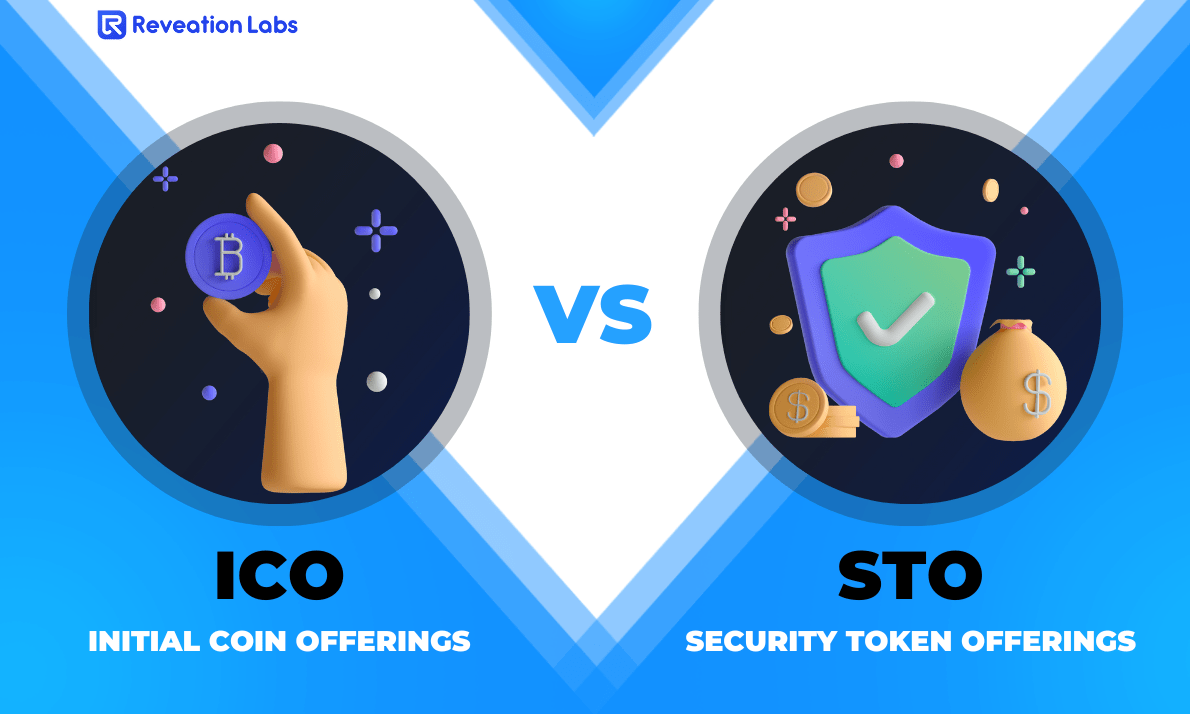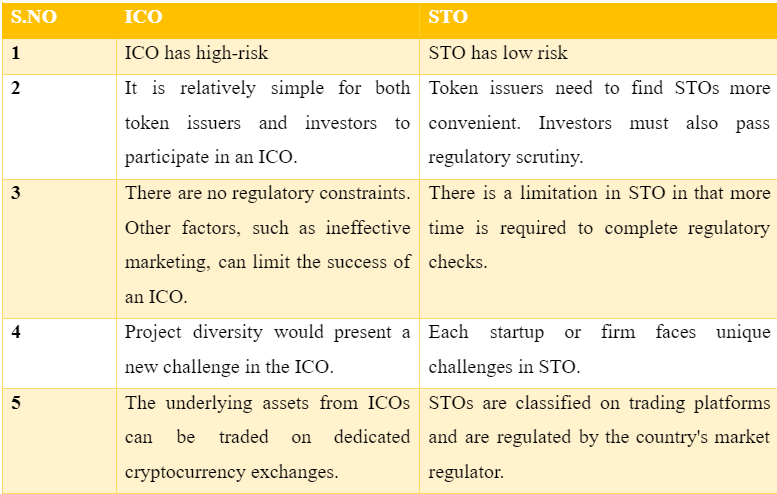Komal Rathi
Fri Mar 10 2023


Introduction
ICO is a fundraising method where new projects or companies issue a new cryptocurrency or token in exchange for funding from investors. The token is often offered at a discounted rate during the ICO and is expected to increase in value as the project develops. ICOs are generally unregulated and often marketed to cryptocurrency enthusiasts.
STO, on the other hand, is a fundraising method that involves issuing tokens backed by a financial asset or security, such as stocks or bonds. STOs are subject to securities regulations and provide investors with more protection than ICOs. STOs are often marketed to traditional investors who are familiar with securities regulations and investment practices.
How is STO different from ICO?
STO (Security Token Offering) and ICO (Initial Coin Offering) are both fundraising methods companies and startups use to raise capital for their projects or businesses. However, there are significant differences between the two:
1. Security vs. Utility:
The primary difference between STO and ICO is that STO is considered a security token offering. At the same time, ICO is an initial coin offering. Security tokens represent an investment contract, giving investors ownership of the underlying asset or company, while utility tokens give users access to a product or service.
2. Regulatory Compliance:
STOs are more heavily regulated than ICOs because they are considered securities and are subject to securities laws. STOs must comply with regulatory requirements, such as filing with the Securities and Exchange Commission (SEC) in the United States, which ICOs do not have to adhere to.
3. Investor Protection:
STOs offer more investor protection than ICOs crypto, as they provide greater transparency and regulation. STOs typically provide more detailed information about the investment opportunity and are subject to strict reporting requirements. In contrast, ICOs are often less transparent, with less regulatory oversight.
4. Investment Potential:
STOs tend to be better investments than ICOs tokens, as they offer investors a greater degree of ownership and a share in the potential profits of the underlying asset or company. ICOs, on the other hand, are often speculative and offer no real ownership or investment potential.
How Do ICOs and STOs Work?
ICOs (Initial Coin Offerings) and STOs (Security Token Offerings) are two fundraising methods in the world of cryptocurrency.
ICO
An ICO is a crowdfunding method that involves the sale of digital tokens in exchange for other cryptocurrencies, typically Bitcoin or Ethereum. These tokens represent a stake in a new project or company and can be traded on cryptocurrency exchanges. ICOs are typically used to raise funds for a new blockchain-based project or cryptocurrency venture.
Launching an ICO involves creating a white paper explaining the project's goals, technology, and how the funds will be used. Investors can then purchase the digital tokens using Bitcoin or Ethereum, and the funds raised are used to develop the project.
STO
An STO is similar to an ICO, but the tokens sold are considered securities and are subject to regulation by government authorities. STOs are typically used to raise funds for more established companies, and the tokens represent ownership in the company, similar to traditional stocks or shares.
The process for launching an STO is more complex than launching an ICO and involves compliance with securities regulations in the jurisdiction where the offering is taking place. The company issuing the tokens must also provide detailed financial information, including audited financial statements and information about the company's management team.
Bridging the gap between crowdfunding and regulation in blockchain
STOs are registered with the Securities and Exchange Commission (SEC) and they take advantage of securities exemptions such as Reg A+. They, therefore, have a lot of similarities to share. For example, tokens issued in STOs give investors some rights to the firm or organization issuing them.
Registration with the SEC is one of the ways in which STOs promise to offer more security to the investor. This is because the registration with the regulator discourages fraudulent individuals, thus allowing only the projects that are legitimate and serious about their pursuit. The registration process is also similar to the Initial Public Offers (IPOs) registration process. This is not only a positive step for investors, but it should also eliminate government concerns.
Market experts are highly confident about STOs and believe the market cap will be more than $10 trillion by 2020. In comparison, ICOs have raised roughly $4 billion so far. ICOs might have dominated the crowdfunding market in 2017, but this year, the concept of STOs is expected to take off hugely by providing investors with safe investment opportunities. It may finally be the highly sought-after solution for crowdfunding through the cryptocurrency market.
Comparison between ICO vs. STO

Examples:
Blockchain Platform to develop ICO:
Blockchain Platform to develop STO:
Conclusion
In today's decentralized finance ecosystem, securities token offerings and initial coin offerings are two of the most common methods of raising funds. Except for the differences in the underlying assets, they are similar to Initial Public Offerings (IPOs). STO tokens are traded on regulated exchanges, whereas ICO tokens are traded on dedicated digital currency trading platforms.
Why Reveation Labs
We are a team that is technically proficient and simultaneously caring for your business. Our ideology is to provide the latest technologies that suit your business well.
Let’s discuss your requirements!
Give your business the next-gen technology it deserves. Be a part of our family of successful enterprises that work on high-end software solutions.
Experts
In all the latest technologies and developments.
Creative
To innovate the best solutions and pick the right technology for you.
Ethical
To always put you first & respect your business values and procedures.
Dedicated
To meet the deadlines and help you until the very end and beyond.
Approachable
For all your business needs and queries at any point of time.
Transparent
In our ways of working.





